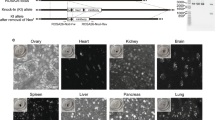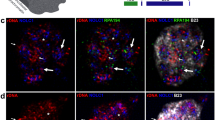Abstract
Phosphorylated forms of Tetrahymena macronuclear histone H1 were separated from each other and from dephosphorylated H1 by cation-exchange HPLC. A homogeneous fraction of hyperphosphorylated macronuclear H1 was then used to generate novel polyclonal antibodies highly selective for phosphorylated H1 in Tetrahymena and in human cells. These antibodies fail to recognize dephosphorylated forms of H1 in both organisms and are not reactive with most other nuclear or cytoplasmic phosphoproteins including those induced during mitosis. The selectivity of these antibodies for phosphorylated forms of H1 in Tetrahymena and in HeLa argues strongly that these antibodies recognize highly conserved phosphorylated epitopes found in most H1s and from this standpoint Tetrahymena H1 is not atypical. Using these antibodies in indirect immunofluorescence analyses, we find that a significant fraction of interphase mammalian cells display a strikingly punctate pattern of nuclear fluorescence. As cells enter S-phase, nuclear staining becomes more diffuse, increases significantly, and continues to increase as cells enter mitosis. As cells exit from mitosis, staining with the anti-phosphorylated H1 antibodies is rapidly lost presumably owing to the dephosphorylation of H1. These immunofluorescent data document precisely the cell cycle changes in the level of H1 phosphorylation determined by earlier biochemical studies and suggest that these antibodies represent a powerful new tool to probe the functions(s) of H1 phosphorylation in a wide variety of eukaryotic systems.
Similar content being viewed by others
References
Adachi Y, Luke M, Laemmli UK (1991) Chromosome assembly in vitro: topoisomerase II is required for condensation. Cell 64:137–148
Ajiro K, Borun TW, Cohen LH (1981a) Phosphorylation states of different histone 1 subtypes and their relationship to chromatin functions during the HeLa S-3 cell cycle. Biochemistry 20:1445–1454
Ajiro K, Borun TW, Schulman SD, McFadden GM, Cohen LH (1981b) Comparison of the structures of human histone 1A and 1B and their intramolecular phosphorylation sites during the HeLa S-3 cell cycle. Biochemistry 20:1454–1464
Allis CD, Gorovsky MA (1981) Histone phosphorylation in macroand micronuclei of Tetrahymena thermophila. Biochemistry 20:3828–3833
Allis CD, Glover CVC, Bowen JK, Gorovsky MA (1980) Histone variants specific to the transcriptionally active, amitotically dividing macronucleus of the unicellular eukaryote, Tetrahymena thermophila. Cell 20:609–617
Annunziato AT, Seale RL (1983) Histone deacetylation is required for the maturation of newly replicated chromatin. J Biol Chem 258:12675–12684
Billings PC, Orf JW, Palmer DK, Talmage DA, Pan CG, Blumenfeld M (1979) Anomalous electrophoretic mobility of Drosophila phosphorylated H1 histone: is it related to the compaction of satellite DNA into heterochromatin? Nucleic Acids Res 6:2151–2164
Bradbury EM, Inglis RJ, Matthews HR (1974) Control of cell division by very lysine rich histone (F1) phosphorylation. Nature 247:257–261
Carter KC, Bowman D, Carrington W, Fogarty K, McNeil JA. Fay FS, Lawrence JB (1993) A three-dimensional view of precursor messenger RNA metabolism within the mammalian nucleus. Science 259:1330–1335
Churchill MEA, Travers AA (1991) Protein motifs that recognize structural features of DNA. Trends Biochem Sci 16:92–97
Clark DJ, Kimura T (1990) Electrostatic mechanism of chromatin folding. J Mol Biol 211:883–896
Cole F, Fasy TM, Rao SS, de Peralta MA, Kohtz DS (1993) Growth factors that repress myoblast differentiation sustain phosphorylation of a specific site on histone H1. J Biol Chem 268:1580–1585
Dadd CA, Cook RG, Allis CD (1993) Fractionation of small tryptic phosphopeptides in high percentage alkaline polyacrylamide gels followed by direct amino acid sequence determination of the resolved peptides. Biotechniques 14:266–273
Davis FM, Tsao TY, Fowler SK, Rao PN (1983) Monolonal antibodies to mitotic cells. Proc Natl Acad Sci USA 80:2926–2930
Earnshaw WC (1991) Large scale chromosome structure and organization. Curr Op Struct Biol 1:237–244
Felsenfeld G (1992) Chromatin as an essential part of the transcriptional mechanism. Nature 355:219–224
Ganju RK, Penkala JE, Wright DA, Davis FM, Rao PN (1992) MPM-12: A monoclonal antibody that predominantly stains mitotic cells and recognizes a protein kinase. Eur J Cell Biol 57:124–131
Glover CVC, Vavra KJ, Guttman SD, Gorovsky MA (1981) Heat shock and deciliation induce phosphorylation of histone H1 in T. pyriformis. Cell 23:73–77
Gorovsky MA, Yao M-C, Keevert JB, Pleger GL (1975) Isolation of micro-and macronuclei of Tetrahymena pyriformis. Methods Cell Biol 9:311–327
Green GR, Lee H, Poccia DL (1993) Phosphorylation weakens DNA binding by peptides containing multiple “SPKK” sequences. J Biol Chem 268:11247–11255
Gurley LR, D'Anna JA, Barham SS, Deaven LL, Tobey RA (1978) Histone phosphorylation and chromatin structure during mitosis in Chinese hamster cells. Eur J Biochem 84: 1–15
Guttman SD, Glover CVC, Allis CD, Gorovsky MA (1980) hea shock, deciliation and release from enoxia induce the synthesis of the same set of polypeptides in starved T. pyriformis. Cell 22:299–307
Hartman PG, Chapman GE, Moss T, Bradbury EM (1977) Studies on the role and mode of operation of the very-lysine-rich histone H1 in eukaryote chromatin. Eur J Biochem 77:45–51
Hendzel MJ, Davie JR (1990) Nucleosomal histones of transcrip tionally active/competent chromatin preferentially exchange with newly synthesized histones in quiescent chicken erythrocytes. Biochem J 271:67–73
Hill CS, Rimmer JM, Green BN, Finch JT, Thomas O (1991) Histone-DNA interactions and their modulation by phosphory lation of-Ser-Pro-X-Lys/Arg-motifs. EMBO J 10:1919–1948
Hohmann P (1983) Phosphorylation of H1 histones. Mol Cell Biochem 57:81–92
Inglis RJ, Langan TA, Matthews HR, Hardie DG, Bradbury EM (1976) Advance of mitosis by histone phosphokinase. J Cell Res 97:418–425
Jackson DA, Hassan AB, Errington RJ, Cook PR (1993) Visualization of focal sites of transcription within human nuclei. EMBO J 12:1059–1065
Kuang J, Penkala JE, Wright DA, Saunders GF, Rao PN (1991) A novel M phase-specific H1 kinase recognized by the mitosisspecific monoclonal antibody MPM-2. Dev Biol 144:54–64
Langan TA, Gautier J, Lohka M, Hollingsworth R, Moreno S, Nurse P, Maller J, Sclafani RA (1989) Mammalian growthassociated H1 histone kinase: a homolog of cdc2+/cdc28 protein kinases controlling mitotic entry in yeast and frog cells. Mol Cell Biol 9:3860–3868
Lennox RW, Cohen LH (1988) The H1 subtypes of mammals: Metabolic characteristics and tissue distribution. In: Stein GS, Stein JL, Marzluff WF (eds) Histone genes and histone gene expression. John Wiley & Sons, NY, pp 373–395
Lewin B (1990) Dividing the cell cycle: M phase kinase, its partners, and substrates. Cell 61:743–752
Li H, Bingham PM (1991) Arginine/serine-rich domains of the su(Wa) and tra RNA processing regulators target proteins to a subnuclear compartment implicated in splicing. Cell 67:335–342
Lin R, Leone JW, Cook RG, Allis CD (1989) Antibodies specific to acetylated histones document the existence of depositionand transcription-related histone acetylation in Tetrahymena. J Cell Biol 108:1577–1588
Moreno S, Hayles J, Nurse P (1990) Substrates for p34cdc2: in vivo veritas? Cell 61:549–551
Norbury C, Nurse P (1992) Animal cell cycles and their control. Annu Rev Biochem 61:441–470
Ohe Y, Hayashi H, Iwai K (1986) Human spleen histone H1. Isolation and amino acid sequence of a main variant, H1b. J Biochem 100:359–368
Ohe Y, Hayashi H, Iwai K (1989) Human spleen histone H1. Isolation and amino acid sequences of three minor variants, H1a, H1c and H1d. J Biochem 106:844–857
Ohsumi K, Katagiri C, Kishimoto T (1993) Chromosome condensation in Xenopus mitotic extracts without histone H1. Science 262:2033–2035
Parseghian MH, Clark RF, Hauser LJ, Dvorkin N, Harris DA, Hamkalo BA (1993) Fractionation of human H1 subtypes and characterization of a subtype-specific antibody exhibiting nonuniform nuclear staining. Chromosome Res 1:127–139
Reeves R, Langan TA, Nissen MS (1991) Phosphorylation of the DNA-binding domain of nonhistone high-mobility group I protein by cdc2 kinase: Reduction of binding affinity. Proc Natl Acad Sci USA 88:1671–1675
Roth SY, Allis CD (1992) Chromatin condensation: does histone H1 dephosphorylation play a role? TIBS 17:93–98
Roth SY, Schulman IG, Richman R, Cook RG, Allis CD (1988) Characterization of phosphorylation sites in histone H1 in the amitotic macronucleus of Tetrahymena during different physiological states. J Cell Biol 107:2473–2482
Roth SY, Collini MP, Draetta G, Beach D, Allis CD (1991) A cdc2-like kinase phosphorylates histone H1 in the amitotic macronucleus of Tetrahymena. EMBO J 10:2069–2075
Spector DL (1990) Higher order nuclear organization: three-dimensional distribution of small nuclear ribonucleoprotein particles. Proc Natl Acad Sci USA 87:147–151
Suzuki M (1989) SPKK, a new nucleic acid-binding unit of protein found in histone. EMBO J 8:797–804
Turner BM, O'Neill LP, Allan IM (1989) Histone H4 acetylation in human cells. Frequency of acetylation at different sites defined by immunolabeling with site-specific antibodies. FEBS Lett 253:141–145
Vandre DD, Davis FM, Rao PN, Borisy GG (1984) Phosphoproteins are components of mitotic microtubule organizing centers. Proc Natl Acad Sci USA 81:4439–4443
Wenkert D, Allis CD (1984) Timing of the appearance of macronuclear-specific histone variant hv1 and gene expression in developing new macronuclei of Tetrahymena thermophila. J Cell Biol 98:2107–2117
Wolffe AP (1991) Implications of DNA replication for eukaryotic gene expression. J Cell Sci 99:201–206
Wood ER, Earnshaw WC (1990) Mitotic chromatin condensation in vitro using somatic cell extracts and nuclei with variable levels of endogenous topoisomerase II. J Cell Biol 111:2839–2850
Wu M, Allis CD, Richman R, Cook RG, Gorovsky MA (1986) An intervening sequence in an unusual histone H1 gene of Tetrahymena thermophila. Proc Natl Acad Sci USA 83:8674–8678
Xie K, Lambie EJ, Snyder M (1993) Nuclear dot antigens may specify transcriptional domains in the nucleus. Mol Cell Biol 13:6170–6179
Xing Y, Johnson CV, Dobner PR, Lawrence JB (1993) Higher level organization of individual gene transcription and RNA splicing. Science 259:1326–1329
Zlatanova J, Van Holde K (1992) Histone H1 and transcription: still an enigma?. J Cell Sci 103:889–895
Author information
Authors and Affiliations
Rights and permissions
About this article
Cite this article
Lu, M.J., Dadd, C.A., Mizzen, C.A. et al. Generation and characterization of novel antibodies highly selective for phosphorylated linked histone H1 in Tetrahymena and HeLa cells. Chromosoma 103, 111–121 (1994). https://doi.org/10.1007/BF00352320
Received:
Revised:
Accepted:
Issue Date:
DOI: https://doi.org/10.1007/BF00352320




